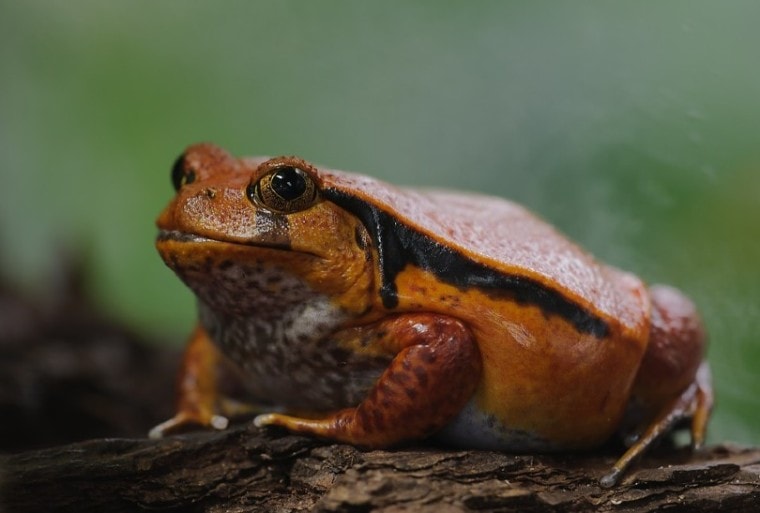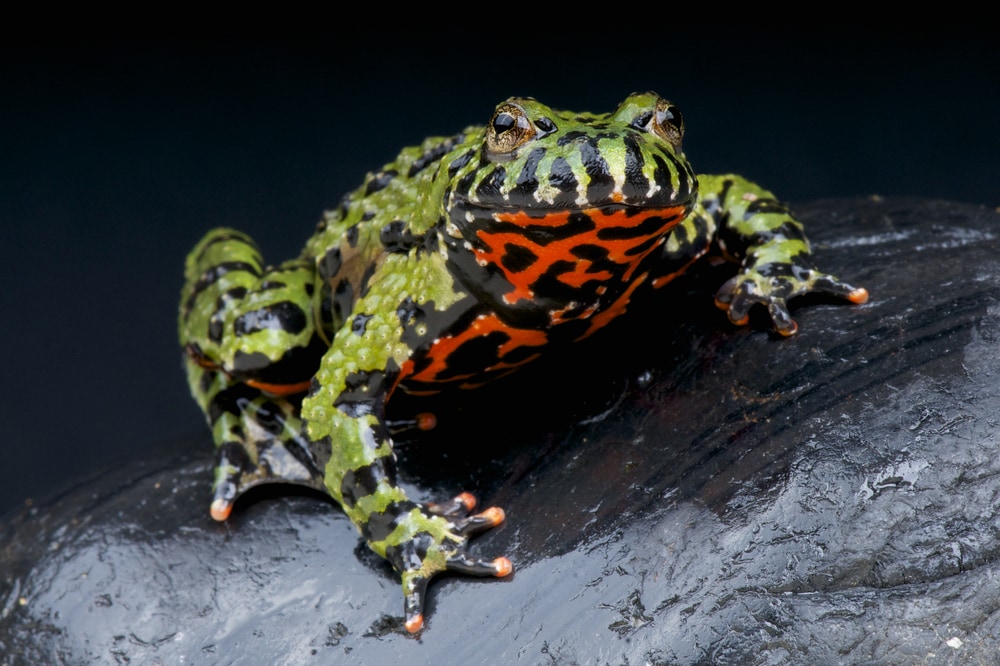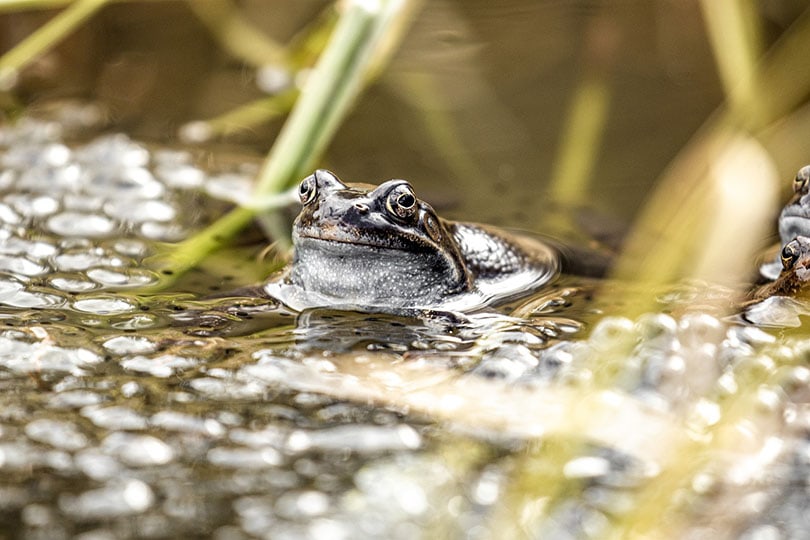
Named both for their bright red color and their ability to “puff up” in self-defense, tomato frogs are unique and relatively easy to care for. Because of this, tomato frogs are one of the more popular amphibians to keep as pets. If you are considering buying a tomato frog, keep reading to find out what you need to know about how to care for these frogs including diet, tank set up, and more!
 Quick Facts about Tomato Frog
Quick Facts about Tomato Frog
| Species Name: | Dyscophus antongilii |
| Family: | Microhylidae |
| Care Level: | Easy |
| Temperature: | 65-80 degrees Fahrenheit |
| Temperament: | Docile but don’t tolerate handling well. Hides and burrows. |
| Color Form: | Adult females: red-orange Adult males: yellow-orange Juvenile: yellow-brown |
| Lifespan: | Average: 6 years Can live up to 10 years |
| Size: | Females: 4 inches Males: 2.5 inches |
| Diet: | Live food: crickets, worms, maggots, etc. |
| Minimum Tank Size: | 10 gallons for up to 2 adult frogs |
| Tank Set-Up: | A substrate deep enough for burrowing, plants (real or artificial), hiding logs, rocks, etc. Shallow water container. |
| Compatibility: | Can only live with other, similar-sized tomato frogs. |
Tomato Frog Overview
Tomato frogs are native to the island of Madagascar, off the coast of Africa. Both wild-captured and captive-bred, tomato frogs are sold as pets worldwide.
Because their care needs are relatively simple and they are generally hardy frogs, tomato frogs are a good choice for beginning frog owners. They will live happily in a basic tank setup so long as it is kept warm and humid and don’t require special lighting like many other reptiles and amphibians.
Tomato frogs don’t require a lot of variety to their diet to keep them healthy either. They are quite happy to live on a diet of live crickets dusted with regular supplements.
While tomato frogs are fun to watch and observe, they do not tolerate or enjoy being handled. This makes them a poor choice of pet for anyone who wants a pet they can snuggle or play with. With tomato frogs, the “look but don’t touch” approach is most suitable.
If you are interested in breeding your tomato frogs, they do typically breed well in captivity. You will need to make sure to provide the right conditions and take careful care of the eggs and tadpoles.
Interested in learning more about keeping a tomato frog as a pet? Read on for more detailed information on how to keep your tomato frog happy and healthy!

How Much Do Tomato Frogs Cost?
Tomato frogs, both adults, and juveniles are usually easy to find year-round at pet stores, reptile shows, or from private breeders. The cost to purchase a tomato frog is usually $20-$50.
As already mentioned, you may find both wild and captive-bred tomato frogs available. It’s generally best to choose a captive-bred frog over a wild one. Frogs bred in captivity are more likely not to have parasites or diseases, which can be a problem in wild frogs.
Typical Behavior & Temperament
As a general rule, frogs should not be handled more than is necessary and tomato frogs are no exception. By nature, the tomato frog prefers to hide and burrow. While they can become tame enough to tolerate minimal handling, it can still be stressful. It’s best to limit the handling of tomato frogs to moving them in and out of their cages for cleaning.
Appearance & Varieties
Technically, tomato frogs are actually three distinct species in the genus Dyscophus.
All three species look so similar that it’s hard to tell them apart, even in the wild.
Young tomato frogs will usually be around 1-1.5 inches long when they are made available to purchase. At this point, their coloring will be brownish-yellow on top and a pale gray-brown on the sides. The young frogs will grow quickly with proper feeding and can reach adult size in just a year.
Adult female tomato frogs will usually grow to about 4 inches long while males are smaller, usually reaching about 2.5 inches long when fully grown. The females are more brightly colored, displaying the vibrant red-orange tones that give the frogs their name. Males have more of a yellow-orange hue, still striking but less so than the females.
The undersides of both male and female tomato frogs are off-white. Some will have dark spots on their backs as well. Tomato frogs also have a dark stripe down their sides from the rear of their eyes to the hind legs. All in all, these frogs are very distinctive and memorable in appearance.

How to Take Care of Tomato Frogs
Tomato frogs are among the easier frogs to care for. Their habitat requirements are relatively simple and they tolerate a wider range of conditions than some other frogs.
Habitat, Tank Conditions & Setup
Here are some general guidelines to follow when setting up a habitat for your tomato frog.
Tank Setup
Tomato frogs need at least a 10-gallon tank to live comfortably. This size tank can hold up to two adult frogs, although it is recommended that the tank be a bit larger if you do want to keep two adults to give them enough space.
Accessorize the inside of the tank with a variety of plants, hiding logs, rocks, etc. Given that tomato frogs burrow into the bottom of their tanks and can disturb roots, live plants might be hard to keep alive. Artificial plants are an acceptable substitute. The bottom of the tank should be filled with at least 2 inches of a material like topsoil (make sure it’s free of fertilizer and pesticides) or coconut fiber to allow the frogs to burrow easily.
Tomato frogs donʻt need a large water habitat but the tank should have a shallow water dish in place.
Lighting
Tomato frogs don’t need any special lighting to stay healthy. They are nocturnal in the wild, so UV lighting is not required. However, if you choose to use live plants in their tank, you will need lighting for the plants. In that case, use a low-wattage bulb and timer set to a day and night cycle. Your plants will get about 14 hours of light and your tomato frog will get 8-10 hours of nighttime in this cycle.

Temperature
Keep your tomato frog’s tank at a temperature of 65-80 degrees F. If you live in a cold climate or keep your house cooler than 65 degrees F, you may need to add a warming pad to your frog’s habitat. Placing a thermometer in the tank is recommended to help you keep the temperature safe for your tomato frog.
As a native of tropical climates, tomato frogs need to live in a humid environment. Mist their tanks every 1-3 days and keep a hygrometer inside to monitor the humidity level. Adding a water-retaining material such as sphagnum moss can help maintain the humidity in the tank as well.
Do Tomato Frogs Get Along with Other Pets?
Tomato frogs are prone to becoming stressed in the presence of predators. For this reason, they should be kept away from predator-type pets like dogs and cats.
If you notice a white substance on your tomato frog’s back, that means they are stressed. The substance is a defense mechanism. Wash it off your hands immediately if you touch it because it can be irritating to human skin.
This predator stress response extends to other inhabitants of the tomato frog’s tank as well. Tomato frogs should only be kept with other tomato frogs of similar age and size.
Larger frogs may cause your tomato frogs stress. Another concern is that the skin secretions of the tomato frog may be poisonous to other types of frogs. In addition, adult tomato frogs may decide that smaller, younger tomato frogs make better snacks than roommates.
What to Feed Your Tomato Frog
Your tomato frog should be fed live food that they can stalk and eat like they would in the wild. Live crickets or nightcrawlers are a good choice.
Tomato frogs prefer to be fed at night. Monitor how much your frogs are eating to be sure you aren’t overfeeding. Crickets, or whatever food you feed, should all be eaten within about 2-3 hours of feeding.
Make sure to keep the shallow dish full of clean water. Tomato frogs will not tolerate many of the additives, such as chlorine, in most tap water. Add a water conditioner to their water to make it safe for them.

Keeping Your Tomato Frog Healthy
Because you won’t be able to feed your tomato frog the same variety of foods they would eat in the wild, you’ll need to add some supplements to their diet to keep them healthy.
Add a calcium supplement to your tomato frog’s food 1-2 times per week. You should also give them a vitamin and mineral supplement once a week.
Helping your tomato frog avoid stress is very important for keeping them healthy. We’ve already discussed a few ways to do that, including keeping handling to a minimum and avoiding predator stress. Keeping your frog’s tank clean, warm, and humid will also help them stay happy and healthy.
A healthy tomato frog should have clear eyes and bright skin, free from the white substance that’s a sign of stress.
Breeding
The first step in breeding any creature is making sure you have a male and female housed together. Fortunately, tomato frog males and females look very different so this is easy to do.
Tomato frogs in the wild usually mate during the rainy season so you will want to mimic this environment in their tank to help encourage them to breed.
Tomato frogs breed and lay their eggs into the water so be sure to have larger, shallow water containers available. The male tomato frog will fertilize the eggs as the female lays them. You should remove the adult frogs from the tank after the eggs are laid. The tadpoles will hatch from the eggs in about 48 hours.
Tadpoles should be kept in clean water and fed flake food until they change into froglets after about 30 days. The froglets should eat crickets or fruit flies with frequent calcium and vitamin supplements for 2-3 months until they are large enough to go to their new homes.
Are Tomato Frogs Suitable For You?
Tomato frogs make suitable pets for a wide variety of individuals and living situations. Because they are quiet and relatively easy keepers, they are a good choice for less experienced frog owners. They are not too expensive to maintain once their initial tank setup is properly accomplished.
The trickiest part of keeping tomato frogs is making sure the temperature and humidity in their tank are kept in the proper range. Otherwise, they don’t need much special care and their diet needs are simple as long as you don’t mind buying live crickets and worms!
Tomato frogs may not be good pets for children who prefer a pet they can handle and interact with. In addition, because they can be stressed by dogs and cats, they may not be suitable for homes where these pets already live unless you can keep the frog in a space away from them.
Final Thoughts
Tomato frogs may not want to cuddle in your lap but that’s not the kind of pet that everyone wants. If you prefer your pets brightly colored, nearly untouchable, and fond of live crickets, the tomato frog might be the pet for you! Just make sure you are prepared to meet their needs before you bring home your new pet to eliminate stress on both of you.
Featured Image Credit: miniformat65, Pixabay

 Quick Facts about Tomato Frog
Quick Facts about Tomato Frog






